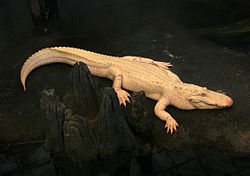 Claude in 2008 in his swamp at the California Academy of Sciences | |
| Species | Alligator mississippiensis |
|---|---|
| Sex | Male |
| Hatched | September 15, 1995 |
| Owner | California Academy of Sciences |
| Weight | 222 lb (101 kg) |
Claude (hatched September 15, 1995) is an albino alligator ( Alligator mississippiensis ) at the California Academy of Sciences in San Francisco, California, United States. Claude lacks the pigment melanin, resulting in colorless skin, and he has poor eyesight associated with his albinism.